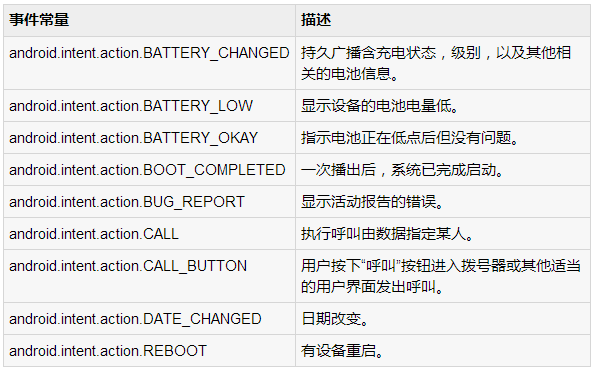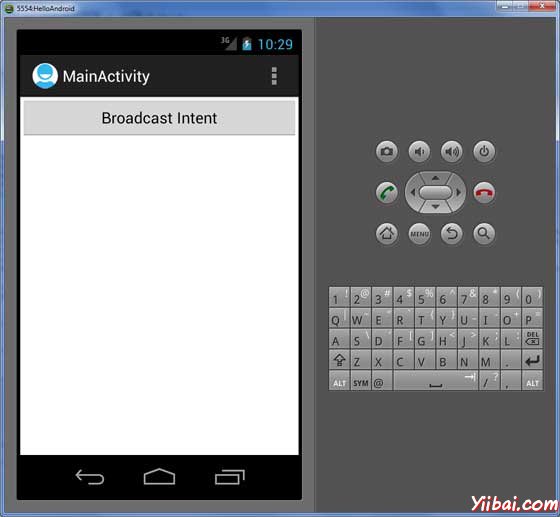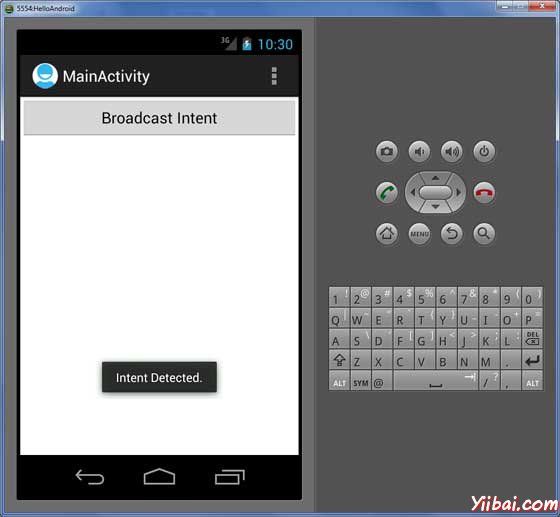|
广播接收器(Broadcast)简单地从其他应用程序或系统响应广播消息。这些消息有时称为事件或意图。例如,应用程序也可以发起广播,以让其他应用程序知道某些数据已经被下载到设备上,可供它们使用。广播接收器会拦截此通信,并会采取适当操作(动作)。
以下两个重要的步骤,在使用广播接收器工作系统及广播意图:
还有一个附加的步骤,要实现自定义的意图,那么将必须创建并广播意图。
创建广播接收器
实现广播接收机BroadcastReceiver类的一个子类并重写 onReceive()方法,其中每个收到消息作为一个 Intent 对象参数。
public class MyReceiver extends BroadcastReceiver {
@Override
public void onReceive(Context context, Intent intent) {
Toast.makeText(context, "Intent Detected.", Toast.LENGTH_LONG).show();
}
} |
注册广播接收器
应用程序侦听特定的广播意图是通过在 AndroidManifest.xml 文件中注册一个广播接收器。寄存器 MyReceiver 系统生成事件 ACTION_BOOT_COMPLETED,在Android系统完成了启动过程后,这是由系统启动执行的。
<application
android:icon="@drawable/ic_launcher"
android:label="@string/app_name"
android:theme="@style/AppTheme" >
<receiver android:name="MyReceiver">
<intent-filter>
<action android:name="android.intent.action.BOOT_COMPLETED">
</action>
</intent-filter>
</receiver>
</application> |
当 Android 设备启动,它会被截获 BroadcastReceiver 的 MyReceiverand 内实现逻辑,首先 onReceive() 将被执行。
有几个系统产生的事件定义在最后意图类的静态字段。下表列出了一些重要的系统事件

广播定制意图
如果希望应用程序本身生成并发送自定义意图,那么必须使用sendBroadcast()方法里面活动类来创建和发送这些的意图。使用(意向)sendStickyBroadcast() 方法意图是粘粘的,这意味着所发送的意图保持周广围播出后完成。
public void broadcastIntent(View view) {
Intent intent = new Intent();
intent.setAction("com.yiibai.CUSTOM_INTENT");
sendBroadcast(intent);
} |
意图 com.yiibai.CUSTOM_INTENT也可以以注册类似的方式,因为我们产生注册系统的意图。
<application
android:icon="@drawable/ic_launcher"
android:label="@string/app_name"
android:theme="@style/AppTheme" >
<receiver android:name="MyReceiver">
<intent-filter>
<action android:name="com.yiibai.CUSTOM_INTENT">
</action>
</intent-filter>
</receiver>
</application> |
示例
这个例子将解释如何创建BroadcastReceiver 拦截自定义意图。熟悉自定义意图后,就可以编写应用程序来拦截系统生成的意图。现在按照下面的步骤来修改前面创建的Hello World范例中 Android 应用程序:

以下是修改主要活动文件 src/com.example.helloworld/MainActivity.java 后的内容。这个文件包括每个生命周期方法。这里添加了 broadcastIntent() 方法来广播自定义的意图。
package com.example.helloworld;
import android.os.Bundle;
import android.app.Activity;
import android.view.Menu;
import android.content.Intent;
import android.view.View;
public class MainActivity extends Activity {
@Override
public void onCreate(Bundle savedInstanceState) {
super.onCreate(savedInstanceState);
setContentView(R.layout.activity_main);
}
@Override
public boolean onCreateOptionsMenu(Menu menu) {
getMenuInflater().inflate(R.menu.activity_main, menu);
return true;
}
// broadcast a custom intent.
public void broadcastIntent(View view)
{
Intent intent = new Intent();
intent.setAction("com.yiibai.CUSTOM_INTENT");
sendBroadcast(intent);
}
} |
下面是 src/com.example.helloworld/MyReceiver.java 的内容:
package com.example.helloworld;
import android.content.BroadcastReceiver;
import android.content.Context;
import android.content.Intent;
import android.widget.Toast;
public class MyReceiver extends BroadcastReceiver {
@Override
public void onReceive(Context context, Intent intent) {
Toast.makeText(context, "Intent Detected.", Toast.LENGTH_LONG).show();
}
} |
下面将 AndroidManifest.xml 文件的内容修改。在这里添加 标签,包括服务:
<manifest xmlns:android="http://schemas.android.com/apk/res/android"
package="com.example.helloworld"
android:versionCode="1"
android:versionName="1.0" >
<uses-sdk
android:minSdkVersion="8"
android:targetSdkVersion="15" />
<application
android:icon="@drawable/ic_launcher"
android:label="@string/app_name"
android:theme="@style/AppTheme" >
<activity
android:name=".MainActivity"
android:label="@string/title_activity_main" >
<intent-filter>
<action android:name="android.intent.action.MAIN" />
<category android:name="android.intent.category.LAUNCHER"/>
</intent-filter>
</activity>
<receiver android:name="MyReceiver">
<intent-filter>
<action android:name="com.yiibai.CUSTOM_INTENT">
</action>
</intent-filter>
</receiver>
</application>
</manifest> |
以下将 res/layout/activity_main.xml 文件的内容包括一个按钮来广播自定义意图:
<LinearLayout xmlns:android="http://schemas.android.com/apk/res/android"
android:layout_width="fill_parent"
android:layout_height="fill_parent"
android:orientation="vertical" >
<Button android:id="@+id/btnStartService"
android:layout_width="fill_parent"
android:layout_height="wrap_content"
android:text="@string/broadcast_intent"
android:onClick="broadcastIntent"/>
</LinearLayout> |
下面将在 res/values/strings.xml 中定义两个新的常量的内容:
<resources>
<string name="app_name">HelloWorld</string>
<string name="hello_world">Hello world!</string>
<string name="menu_settings">Settings</string>
<string name="title_activity_main">MainActivity</string>
<string name="broadcast_intent">Broadcast Intent</string>
</resources> |
现在运行修改后的 Hello World!应用程序。假设创建了AVD并设置了环境。要从Eclipse运行的应用程序,首先打开一个项目的活动文件,从工具栏单击“run” Eclipse Run Icon 图标。 Eclipse AVD安装的应用程序,并启动它,如果设置和应用都没有问题,将会显示以下模拟器窗口:

现在广播自定义的意图,点击上广播意图按钮,这将广播自定义在 “com.yiibai.CUSTOM_INTENT” 注册BroadcastReceiver 的意图将被 MyReceiver拦截。 实现的逻辑如下出现底部的模拟器:

可以尝试执行其他 BroadcastReceiver 拦截系统的意图,如系统启动,更改日期,电池电量不足等。
|
